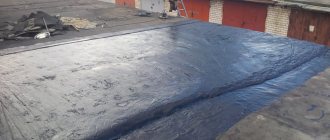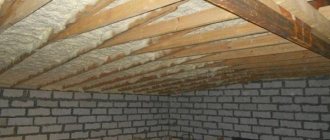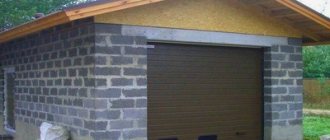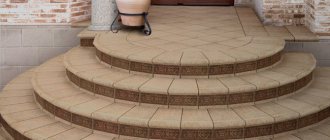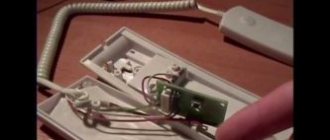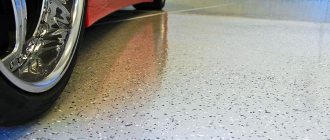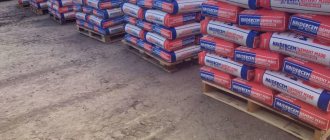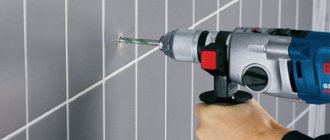The roof is leaking: how to protect the garage roof from leaking
Although a garage is not a living space, the roof should not be allowed to leak. That is why the question of how to cover the garage roof from leaking is one of the main ones.
In addition to the fact that humidity negatively affects the condition of the vehicle and spare parts stored in the garage, it can have a destructive effect on the walls of the building. A leaking roof can cause mold and mildew to form on the plaster. Moreover, being in such a room will be harmful not only to the car, but to its owner. In this situation, the owner begins to think about what to do if the roof leaks.
To avoid such troubles, it is necessary to carry out thorough and timely roof repair work. Much depends on the material with which the garage roof will be covered and on how well the seams are sealed.
Preparing for work
The most common option is when monolithic concrete floors are used in the construction of a garage. In such cases, it is necessary to carry out especially careful preparation for working with the roof. It is worth noting that the roof covering process can only be carried out in dry and warm weather.
Before installing a new coating, you should get rid of the old one. It is not recommended to place new material on top of old one. Some people think that cleaning the base will be a waste of time, and the old coating will make the roof more durable. However, experts claim that this is the wrong approach, since a poor coating will not make the structure more reliable. Moreover, this will make it impossible to lay the new material evenly.
To clean the base, you need to stock up on the right tools and patience. This will require the use of physical force. To get rid of old material you will need a chisel, a wide knife and an ax. All tools must be pre-sharpened. Using an ax, notches are made on the old roof, and then the roofing material is pryed with a knife and torn off. Where the process will be especially difficult, you should use a chisel or chisel.
Sealing cracks
If the roof in the garage is leaking in several places at once, then after removing the roofing material all problem areas will become visible. The slab must be freed from all defects. Large cracks at the junction of plates are sealed using polyurethane foam. Before using it, you should thoroughly clean the surface with a brush to improve adhesion. Next, the foam should harden completely. The required time is indicated in the instructions. Then the excess is removed with a knife, and the gap is covered with cement-sand mortar.
When working with small cracks, the current area can be repaired using liquid glass. If the slab has collapsed along the edges, it is restored with a cement-sand mortar, having previously treated the surface with a primer.
In addition to the cracks in the slab, it is worth eliminating defects; the depressions are filled with a solution of sand and cement, and the protruding areas are ground off with a hammer and chisel. If there are exposed areas of reinforcement on the slab, they should be treated with a rust preventative, for example, phosphoric acid.
It is worth remembering that the slab should be slightly inclined. If the required slope of 5 degrees is missing, this must be corrected with an uneven screed.
Useful video: everything for repairing and covering the roof
And now it’s time to see everything with your own eyes: here are some excellent videos about repairing and covering garage roofs with your own hands. You will learn from them what is the best way to seal leaks on a garage roof, how to proceed correctly when laying new material, what techniques and methods to use, and how to work with various materials.
We use TechnoNIKOL
The following video describes in detail how to cover a garage roof with modern roll material TechnoNIKOL. Everything is presented in the most accessible, visual form.
We partially repair
This video examines a partial roof repair.
https://www.youtube.com/watch?v=wuJx6qsTTLI&feature=youtu.be
Restoring a concrete roof
Do you have a concrete garage roof? Are there any holes or potholes? It is worth using bitumen mastic to eliminate all defects. See exactly how this is done.
Repairing a slate roof
If you have a slate roof on your garage, the following video will be very useful to you. It shows in detail how to carefully repair slate flooring.
Thorough renovation
Another video allows you to visualize the entire labor-intensive process of repairing a garage roof.
Corrugated roofing
See how to lay and repair a corrugated roof with your own hands. There are some working secrets here that are specific to this material.
We restore the roof with our own hands
Garage workers often prefer to repair the roof when the garage roof is leaking, with their own hands. The following video on the careful restoration of roofing materials is worth watching.
You learned a lot of useful information and tips. If the roof in the garage is leaking, and during inspection you have identified some defects, you should immediately begin repair work. And it is not always necessary to lay a new roof, since it is often enough to restore the old covering. And it will last for a long time.
Roof waterproofing
First of all, you need to decide on the material that will be used to protect the garage from moisture. This can be European or a regular version of roofing felt. The first type of coating is considered more durable and durable. Before starting to work with euroroofing felt, there is no need to treat the slab with bitumen. The material warms up well before laying, after which it adheres well to the surface.
Ordinary roofing felt can be laid exclusively on bitumen or bitumen mastic. Despite the fact that this option is much cheaper than the European one, its service life is much shorter. In addition, ordinary roofing felt should be laid in 2 layers, which is not so cheap.
Experts recommend not saving on roof coverings and using euroroofing felt. In this case, you will not have to replace the roof frequently, and the garage roof will be reliably protected from precipitation.
Garage roof waterproofing materials
A good choice and proper installation will provide the room with both warmth and dryness, and will also help it function for many years as a complete protection of the car from atmospheric agents. Let's take a closer look at the most popular materials for roof waterproofing.
Waterproofing for garage roof
Hydroisol is a fiberglass-based material rolled into convenient rolls. In addition to fiberglass, the composition contains polymers and bitumen.
Waterproofing is especially suitable for flat roofs or garage roofs with a slight slope. The quality of the coating is better than roofing felt.
Advantages of waterproofing:
- high strength;
- excellent elasticity indicators;
- muffles the sound of rain;
- excellent resistance to any weather conditions;
- service life is very long.
Hydroisol is laid in three ways: hot, mechanical, with bitumen mastic.
Liquid rubber
An emulsion of bitumen combined with synthetic resins turns into liquid rubber. The consistency, method of application, and characteristics allow it to be ranked alongside polymer mastic. The resulting membrane is elastic and durable, the material does not peel off.
Liquid rubber is very convenient for roof waterproofing; the material is modern and of decent quality.
Be sure to study the label, it is possible to confuse liquid waterproofing rubber and similar paint
The coating will last for decades, and roof repairs will most likely not be needed, even if the climatic conditions are harsh. The composition is suitable for covering roofs of any type and material, but it is chosen mainly by professionals.
Rubber is applied in two layers by spraying, using a spatula, brush, or pouring onto the surface.
Liquid rubber is also combined with water-based paints. This is done so that the coating is decorative.
If you apply two layers of different colors, it is easy to avoid gaps
Bitumen mastic
Bitumen resin made it possible to produce a very plastic adhesive composition. Some manufacturers include polymers in the material.
Bitumen mastic can be hot or cold, each with its own application features and characteristics.
Hot mastic is in a solid state, and after heating it becomes liquid and ready for application.
The cold version is sold in the form of a thick liquid, and before starting work, a solvent is added to it.
Bitumen mastic has a long service life, as manufacturers claim, at least 25 years. The material does not lag behind the base even after several years, and is not particularly expensive.
But there are some drawbacks: you can’t walk on such a roof because of melting on very hot days, and the product is not used as a stand-alone covering.
Polymer mastic
Polymer mastic is similar to bitumen, but the performance characteristics are better. This material is good when you need to treat a small roof, especially if work is carried out during construction. But you can cover the roof with waterproofing mastic at any time during the use of the garage.
It’s convenient that the product can be purchased immediately in a large metal container.
The price of the product is high, which can be considered a minus.
Membrane
For roof waterproofing, EPDM membranes and PVC are used.
EPDM membranes are composed of rubber and ethylene-propylene-diene monomer. The product is based on a polymer mesh, which serves as a reinforcing layer and gives strength to the material. Thanks to this approach to manufacturing, such sheet membranes can be used for different climatic conditions.
Installation is simple: with rolls up to 15 meters in width and up to 60 meters in length, you can cover a large surface area, and at a fast pace. The service life is very long.
The weight of the membranes is small, which also facilitates installation.
Unfortunately, if the roof surface is large, then one roll will not be enough; you will need to arrange a joining seam. What is needed is vulcanization of the seam, not gluing it, which will not last long and will collapse.
If we talk about the cost of such waterproofing, then this material will outstrip all other waterproofing materials in price.
PVC membranes are also sold in the form of rolls with polyester reinforcing mesh inside. Plasticizers are used as fillers for waterproofing materials. The membrane is applied overlapping, and the joints need to be reinforced with a torch, and the resulting seams are very strong.
The product's advantages compete with EPDM membranes, but the price is better.
Working with regular and euroroofing felt
There should not be any particular difficulties with this material. The roofing material is heated using a soldering iron or a gas burner. This procedure must be carried out carefully so that the material adheres well to the base. It is best to heat the roofing material to a boiling point.
Care must be taken to ensure that no air bubbles form under the coating. Each new row of roofing material is laid overlapping the previous one. The recommended overlap width is 15 cm. The covering should extend 10 cm beyond the slab. This will help avoid leaks.
Despite the fact that euroroofing felt is considered a higher quality and reliable option, conventional coating is in considerable demand. The reason for its popularity is its low cost.
Before you start working with roofing felt, you need to level it. To do this, the roll is rolled out in the opposite direction. Next, you need to treat the base with mastic or bitumen. The first option is much better, since the mastic does not crack over time and withstands low and high temperatures better. The mastic is heated to 200 degrees and immediately applied to the surface. Ruberoid is placed while it is hot. The seams that are formed when laying the material should also be treated with mastic.
If the work is carried out correctly, the roof will reliably protect the building from moisture for many years.
How to fix a leak in the garage roof with your own hands: repairs and what to fill the roof with so that it doesn’t leak
This article will talk about repairing a garage roof with your own hands. Roofing is usually divided into two types - soft and hard. The repair technology depends on this and the type of roofing material.
The capital of repair work is also divided into two types - local and capital. In case of minor damage to the surface, you can get by with little money and labor.
If the garage roof is leaking and the damage is extensive , then you will have to do a major repair of the garage roof. This means completely replacing the garage roof and laying a new layer. Most often, this occurs due to wear and tear of materials.
The service life is coming to an end, numerous smudges appear. The most difficult case will be the task of repairing the roof sheathing and frame. So, let's find out how to protect the garage roof from leaking .
When is garage repair required?
The first sign that a garage is unsuitable for further use in most cases is the appearance of moisture in the room itself after rain or melting snow. Even a minor leak can cause damage to the car, the appearance of dampness, and fungal growths. Any deformed area of the roof needs timely repair.
The reason for garage roof repair may be:
- adverse effects of weather conditions;
- bad ecology;
- non-compliance with the stages of roofing work;
- improper preparation of the premises;
- poor quality of materials used;
- lack of timely repair of minor roof defects;
- violation of waterproofing due to destruction of the bitumen layer;
- Wetting of the insulation, which leads to swelling of the under-roof covering;
- negative impact of ice formed due to melting snow covers.
Only a well-built garage can guarantee the safety of your car.
Garage roofs: repairs
Even a well-made roof can become leaky. Leaks appear from cracks and gaps, and water begins to penetrate into the garage. All this has an extremely negative impact on storage conditions. Leaks provoke the appearance of fungus, mold, and increase the overall humidity in the room. A car and other things run the risk of becoming unusable in a short time.
To prevent this, all leaks that occur must be promptly detected and repaired . Most often, a garage roof leaks at the junction of slabs or roofing elements (rolls, panels, etc.). In addition, the edges of the roof are at risk. Water likes to seep along the walls into the garage.
Garage Roof Insulation
All roofs are reinforced with internal waterproofing . Without it, protection from precipitation will be incomplete. For these purposes, various materials and methods are used. The most common are extruded foam and roofing felt. The base and roof sheathing are laid out with these materials. They are secured with glue or nails.
In addition, to create waterproofing , we must not forget about the structural elements - drainpipe, ridge, and so on. Only all technical solutions taken together guarantee the absence of water in the garage.
Surface integrity can be compromised for many reasons. The two most obvious are coating wear and external influences.
The coating itself may lose its protective properties.
Each material has a certain service life.
Therefore, you should not be surprised if the coating, which was laid 20 years ago , began to let water into the garage.
The soft roof of the garage roof becomes covered with swelling and cracks from age.
This is usually the most likely prerequisite for starting a major overhaul.
The second reason is the physical impact on the surface, for example, in strong winds, branches or other objects can damage the roof. In this case, you also cannot do without repairs, but you can limit yourself to local ones . That is, do not change the entire canvas, but repair only the damaged areas.
In total, there are two main types of roofing - soft and hard . The difference lies in the materials used. For soft roofing, for example, roofing felt and its modern analogues are used. When creating a rigid roof, corrugated sheeting and slate . Small gaps (up to 5 millimeters) can be treated with construction foam.
But in case of major damage, full repairs should be undertaken. The cost of repairing a garage roof largely depends on the scale of the work, the type of roofing and the material chosen. Let's look at some options.
Rolled soft roofing
If the roof in the garage is leaking along the joint of the slabs , what should you do in this case? If you find leaks, then, as always, repairing the roof of the garage roof must begin with the preparatory stage . First of all, you should climb onto the roof and clean its surface from litter, dirt, and leaves. Then the size of the damage is assessed.
If they are not very large, you can do without completely removing the roof sheet and stick to local repairs . In this case, the damaged area is cut down with an ax. The edges are folded to the sides so that they do not interfere. The surface is dried from moisture using a burner. After this you can lay the roll.
Often, for local repairs, car owners take the cheapest and most common rolled material - roofing felt . It is ideal for covering a small area.
Several pieces are cut from the roll. The size of the pieces is determined based on the length and width of the damage.
Then a roofing felt patch is placed on the leakage site. of mastic is applied to a piece of roofing .
The renovation is almost complete. The bent edges are folded back and the patch . Another piece of roofing felt is laid on top.
But the dimensions of the second patch should be slightly larger than the first, adding 10-20 centimeters in width and length.
Then they are treated again with resin or mastic. It is highly recommended to carry out such repairs in warm and dry weather. Instead of roofing felt, you can take bikrost - a modern analogue of roofing felt.
But all this is applicable for relatively minor damage. What to do if during the inspection you find a lot of smudges, large-scale wear of the canvas, in this case, how to repair the garage roof? First you need to completely replace the garage roof.
To do this, use an ax or knife, cut the old rolls at the ends and tear them off the roof. Then the surface is prepared in the same way - cleaned and dried. After this, the installation of the soft roof begins. The process is completely identical to installation from scratch. The most difficult and time-consuming repair will be repair and replacement of the sheathing . But this happens quite rarely; the garage must be quite old for the sheathing to become unusable.
Metal coating
The second type of covering is rigid roofing . Metal rigid roofing is quite common and popular due to its low cost. Unfortunately, metal is more prone to corrosion than rolled synthetic materials.
How to fix a leak in the roof of a metal garage? To begin repairs, they first conduct an assessment to determine how labor-intensive the process will be. For minor damage, cracks and smudges, it will be sufficient to use special waterproofing paint, or “rubber” paint. Small cracks are sealed with tow .
If holes were found during inspection, then you should use soft rolled material, for example, roofing felt .
It is laid directly on the roof surface, having previously cleaned and prepared it.
How to fix a garage roof if there are large holes in the roof?
In this case, waterproofing paint and roofing felt will not work .
Rolled materials sag in such an area and do not protect well from precipitation.
To do this, purchase a sheet of roofing iron from a hardware store and cut out a metal patch with the required dimensions. Attach the metal patch using self-tapping screws .
When repairing slate, a big advantage is its modularity. If the roof in the garage is leaking, the damaged slate sheets can be easily removed and replaced with new ones. First, the nails are removed from the sheets and the old sheets are dismantled. After this, installation . It is recommended to lay slate starting from the bottom corner and ending with the top.
It is advisable to withstand overlap (10-15 centimeters). Waves of sheets are stacked one on top of the other. All excess protrusions are cut off with a grinder. Nails are used for fastening. The occurrence of cracks is avoided by creating holes. Nails are driven into these holes. The edges of the roof are additionally protected with plastic overlays. They will prevent chipping.
How to fill the garage roof so it doesn't leak? The surface is cleaned and the composition is mixed. The composition includes PVA glue, cement, asbestos material. Three parts asbestos are added to two parts cement. Water and glue are poured into the resulting mixture; they are taken in a one to one .
The workpiece is mixed until a thick consistency is obtained. After this, the damaged slate is primed with PVA glue. The cracks are treated with the composition two to three times. Such repairs will extend the life of the roofing by approximately five years .
Bituminous shingles
The garage roof is leaking, what should I do? Repairing asphalt shingles is easy.
Sheets that are damaged are removed along with nails. To do this, use a regular nail puller.
The nails must be pulled out carefully, otherwise normal tiles may be damaged.
After this, the adjacent sheets are lifted to create free space.
A new sheet of asphalt shingles is laid over the damaged area and secured again with nails. It is advisable to carry out the work with a partner, since the sheets are quite heavy.
The complexity of the work depends on the size of the leaks , but in general the repair looks exactly the same for any scale of damage. Particularly vulnerable places are joints with pipes and hoods.
To enhance the protection of joints, use rolled bitumen and sheets of tin. The tin patch is bent around the pipe and then wrapped in a roll of bitumen.
Types of garage roofs
First, let's find out what types of garage roofs there are. Often, garage spaces are built separately from the house. In this case, the roof can be single-pitch or gable. The easiest way to make a roof is from slate, corrugated sheets, rolled materials, for example, roofing felt. Some owners try to create a unified ensemble on the site, so they make the same type of roofs for a residential building and a garage.
Sometimes garages are built as an extension to a residential building, creating a complex structure. Then the roof of the garage becomes part of a complex roof. Of course, the materials are the same in most cases.
There are also garage cooperatives. In them, buildings most often have roofs in the form of a permanent ceiling, for example, a reinforced concrete slab. Rolled materials can be used as a covering.
Why does my garage roof leak?
If the garage roof begins to leak, then the rafter system and wall decoration first begin to deteriorate. Leaks occur due to defects in roofing materials. Often the cause is damage to low-quality roofing, or if all roofing work was carried out by unskilled workers.
Leaks can cause the following damage:
- Cracks . Due to temperature fluctuations, cheap rolled roofing material begins to become dotted with cracks through which moisture penetrates.
- Defects due to mechanical impact . Soft roofing can be damaged by falling branches, stones and debris.
- Mold accumulation . The harmful fungus softens the roofing material, making it vulnerable to leaks.
If your garage roof is leaking, how can you fix it if you need to invest a minimum of money? It's simple, you can fill the garage roof with bitumen.
Tips for cooking bitumen
First of all, let's look at how to properly prepare a bitumen solution for pouring a garage roof. The popularity of bitumen for covering garage roofs is determined primarily by its relatively low cost compared to other materials of this type. But it is worth remembering that a bitumen roof can begin to leak when the sun’s rays are constantly directed at it, and in winter, such a coating can crack. But, if bitumen is the only option, then it needs to be welded correctly.
To prepare 10 kg of mastic, you need to use 8.5 kg of bitumen, 0.5 kg of used crankcase oil, 1 kg of asbestos, sawdust, chalk or other suitable filler.
It is best to cook bitumen in a container that has thick walls, as there is a risk of the material burning. The heating temperature is in the range of 160–200 degrees, the higher it is, the less you need to cook the mixture. Typically, preparing the material takes about three hours.
Important! There is no need to raise the temperature above 200 degrees, as coke may form inside the mixture, which will cause the finished coating to crack.
As soon as the mass becomes homogeneous with a glossy surface, it means that the bitumen is ready. If bubbles and yellow-green smoke appear, the mixture is overheated and may be spoiled.
Once it has become clear that the mixture is ready, it must be removed from the heat and added crankcase oil and filler in small portions. You can immediately fill the prepared roof with bitumen.
How to get rid of leaks
When deciding how to fill a garage roof, you must first evaluate the entire scope of the upcoming roofing work. To do this, the roof is inspected for damage.
Based on the size of the defects, one of the following types of repairs may be necessary:
- Spot . If the damaged area occupies less than 10%, then spot repairs are made to get rid of minor defects. In this case, the damage is filled with bitumen or covered with patches.
- Current . In this case, it is expected to eliminate damage with an area of 15-20%. With such repairs, a partial replacement of the (top) layer of waterproofing is carried out.
- Capital . If the volume of damaged areas exceeds 40%, the old material is completely dismantled and replaced with new one. It is considered the most expensive type of repair, which is carried out once every 10-15 years.
It is worth remembering that timely inspection and restoration of damaged areas will guarantee a long service life of the garage.
Methods for eliminating leaks
When deciding what to do if a garage roof leaks, it is important to correctly assess the scope of roofing work. To do this, you need to carefully inspect the roof surface and identify any existing defects. The technology for restoring the roofing sheet depends on the area of damage. Depending on the volume of defects, you can do the following:
- Spot repairs. If the area of damage does not exceed 10%, then spot repairs are made to eliminate minor defects (cracks, holes, mechanical damage). This damage can be filled with bitumen or covered with patches.
- Maintenance. To restore a roofing sheet with an area of 15-20% damage, routine repairs are carried out with partial replacement of the waterproofing material. To do this, you need to remove the top, worn layer of the roof and cover it with a new one.
- Major renovation. If the amount of damage exceeds 40%, then a major repair is performed. It consists of completely dismantling the old coating and laying a new one. This is the most expensive type of repair, which is recommended to be done once every 10-15 years, depending on the quality of the roofing material.
Repairing small cracks - what to fill with
If the cause of the leaks turns out to be minor cracks that appear on the roofing material due to temperature changes, then in this case there is nothing better than to fill the garage roof with bitumen in problem areas. Solid bitumen, which is melted before work, or liquid bitumen, ready for use, is suitable.
Cracks need to be repaired using the following technology:
- All debris and dust are removed from the roof surface;
- using a grinder with a grinding disc or sandpaper, remove the layer of protective coating in places where cracks are sealed;
- the base of the roofing material is degreased, for which you can use gasoline, acetone or alcohol;
- then take the prepared bitumen and slowly pour it into the crack;
- after the bitumen has hardened, this operation is performed one or two more times, until the damaged area in the roofing material is completely leveled.
- To avoid damaging the area being restored, it can be sprinkled with quartz sand or stone chips.
It is worth noting that to eliminate cracks it is better to use cold bitumen. Hot bitumen must be used with extreme caution and as quickly as possible, while cold bitumen is ready for use straight from the package. To get rid of small cracks, one can of such material will be enough.
We patch the canvas using patches
There is another method of closing leaks that will help you figure out how to close the garage roof to prevent leaks - installing roofing felt patches. They are perfect for eliminating minor damage that has appeared in different places on the canvas. To make patches you will need roofing felt with flake or coarse dusting, bitumen mastic, a knife, varnish and a piece of emery.
For this method of eliminating defects, you will need to perform the following steps:
- Clean the roof. The base of the slopes must be thoroughly cleaned of dust and other contaminants.
- Preparation. The protective coating is removed from the restored surface, and to ensure better adhesion between the layers, they are degreased and dried.
- We make patches. We take roofing material and cut patches - their size should be one and a half to two times the area of the defective area. In order for the patches to acquire an even shape, they are placed on a flat surface for 1-3 hours.
- Next, bitumen is poured onto the treated area to obtain a film that will improve the adhesion of the patch.
- The inner base of the roofing felt patches is heated with a gas burner, and then pressed firmly against the problem area of the roof.
- Next, the upper part of the patch is opened with one or two layers of kukersol varnish or bitumen mastic to increase the waterproofing qualities of the restored area.
It is worth noting that to create patches, it is advisable to take roofing material with a density of at least 400 g/m2 with stone powder. To simplify the work, you can take material with a self-adhesive base, and they should only be performed at ambient temperatures above 5 ℃.
How and what to fill a garage roof with - we do the repairs ourselves
For any real motorist, the garage is rightfully considered a sacred place, because it not only maintains your vehicle, but also stores many things that simply do not fit in the house. Even though such a structure cannot be called residential, its roof should not cause problems for its owner. In this article we will talk about how to fill the garage roof so that its coating does not leak.
Now that you have assessed the scale of the problem, you need to act. There are two ways to repair the roof - using patches or completely re-covering the roof.
If the entire roof is in good condition, there are very few holes, cracks, or swellings on it, then you can apply patches and install them on those areas that are causing water leaks. The payment is made as follows:
In the place where the roofing material flows, a cross is allowed, the edges of the cutout are bent. Now you need to pour resin or bitumen mastic into the resulting square or rectangle, and then apply a pre-cut patch to this place. Now we pour resin onto the patch again and bend the edges of the cut roof back. You need to put another patch on top, which will be much larger than the hole. After this procedure, the problem area will become resistant to moisture.
Complete roof repair
If the roof has many problem areas, then it will be easier to re-lay the entire roofing material. To do this you need:
The roof is coated with resin or bitumen mastic, and a roll of roofing material is rolled out at this point. Each new section should overlap by at least 10-20 centimeters. One layer will not be enough, so you need to lay a few more. Each subsequent layer should be positioned perpendicular to the previous layer to avoid leaks at the junction of the layers.
Slate roof repair
This material is extremely poorly repaired. There are repair methods, but they are complex and expensive, here is one of them:
- You need to remove all the slate, wash and dry it.
- Whole sheets are treated with drying oil.
- Cracks in slate are repaired using strips of fabric that are pre-soaked in oil paint.
- Completely damaged sheets can be replaced with new ones of the same size. You will have to make holes in them for fastenings.
- All slate is mounted back onto the roof. Next, it will need to be painted with special paints for such a coating.
Repair of ondulin or similar materials
In this case, it will be enough to clean the cracks and the surface around them with a solvent and seal the holes with sealant. It should be poured as deep into the cracks as possible, and then add a little on the surface. After this procedure, the coating will serve you for many years. If the cracks and defects are too large, then you should think about completely replacing the roof.
How to carry out routine repairs correctly
If the roof has significant damage, then simply sealing the cracks on the garage roof with something will not work - you will have to partially replace the material. Sometimes there is no need to install a new coating, however, if bubbles appear on the surface, then first of all the top layers of material under which water has collected are removed.
To properly cover the slope with new sheets of roofing material, you will need:
- Dismantle old material. Remove 1 or 2 layers of used roofing felt, on which a large number of blisters and other defects have formed.
- On the bubbles that have formed on the surface of the roof, make a cross-shaped cut in the center with a knife, remove all moisture from them, and then allow them to dry.
- The layer of powder is removed from the base of the roof. To speed up the work, which is not enough, it is better to take a grinder with a special attachment. Keep in mind that all actions must be performed with extreme care so that holes do not appear in the roofing material.
- The prepared base is primed with bitumen mastic to obtain a sticky film - this will allow the new layer of roofing felt to adhere better.
- A few hours later, after the mastic has partially set, proceed to installing a new layer of roofing material. It is laid with a slight overlap of 10-15 cm. The inner base of the material, covered with fusible bitumen, is heated, and then pressed firmly against the old coating.
- The second strip of roofing material is placed at intervals from the first. If you don’t know how to coat the seams on the garage roof, then the same bitumen mastic will do.
Experts advise repairing garage roofs only in dry, calm weather and at ambient temperatures above 5 ℃. To avoid injuring yourself, follow safety rules and do not neglect insurance.
Maintenance
If the garage roof is damaged quite severely, then the roof is restored with partial replacement of the roofing material. In some cases, installation of a new coating can be done without dismantling the old one. However, if there are swellings and bubbles on the roof surface, then you first need to remove the top layers of rolled roofing material, under which moisture has accumulated. In order to properly cover the slope with a new layer of roofing felt to eliminate leakage, you must:
- Remove the old covering. 1-2 layers of worn roofing material are dismantled, the surface of which has a lot of swelling and damage.
- If there are swellings on the roof surface, they must be cut crosswise with a knife, the moisture squeezed out, and then left to dry.
- A layer of topping is removed from the roof surface. Since the amount of work is quite large, grinding is easier to do with a grinder with a special attachment. However, you need to act carefully so as not to rub the roofing material into holes.
- The coating from which the topping has been removed is primed with bitumen mastic to create a sticky film that improves the adhesion of the new layer. Ruberoid.
- After a few hours, when the mastic has set a little, you can begin laying a new layer of roofing material. Installation of roofing felt is carried out with the strips overlapping each other by 10-15 cm. The bottom layer of low-melting bitumen material is heated with a burner and then pressed with a roller on top of the old coating.
- The second layer of roofing material is laid at intervals from the first so that the joints on them do not coincide.
Experienced craftsmen say that garage roof repairs should be carried out in dry, windless weather at temperatures of +5 degrees and above. To avoid injury, you need to work in compliance with safety regulations and use insurance.
